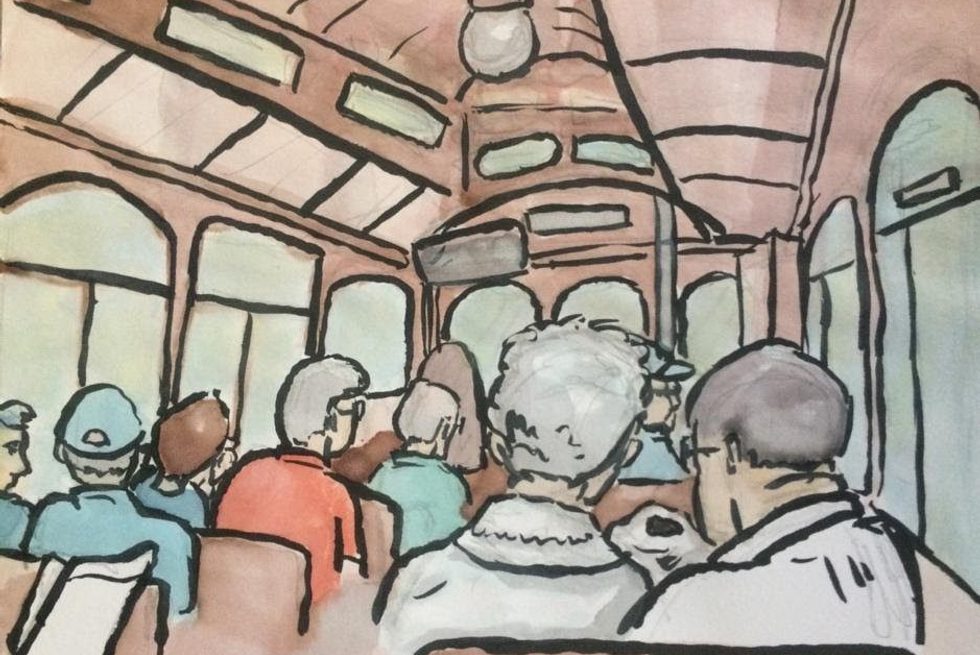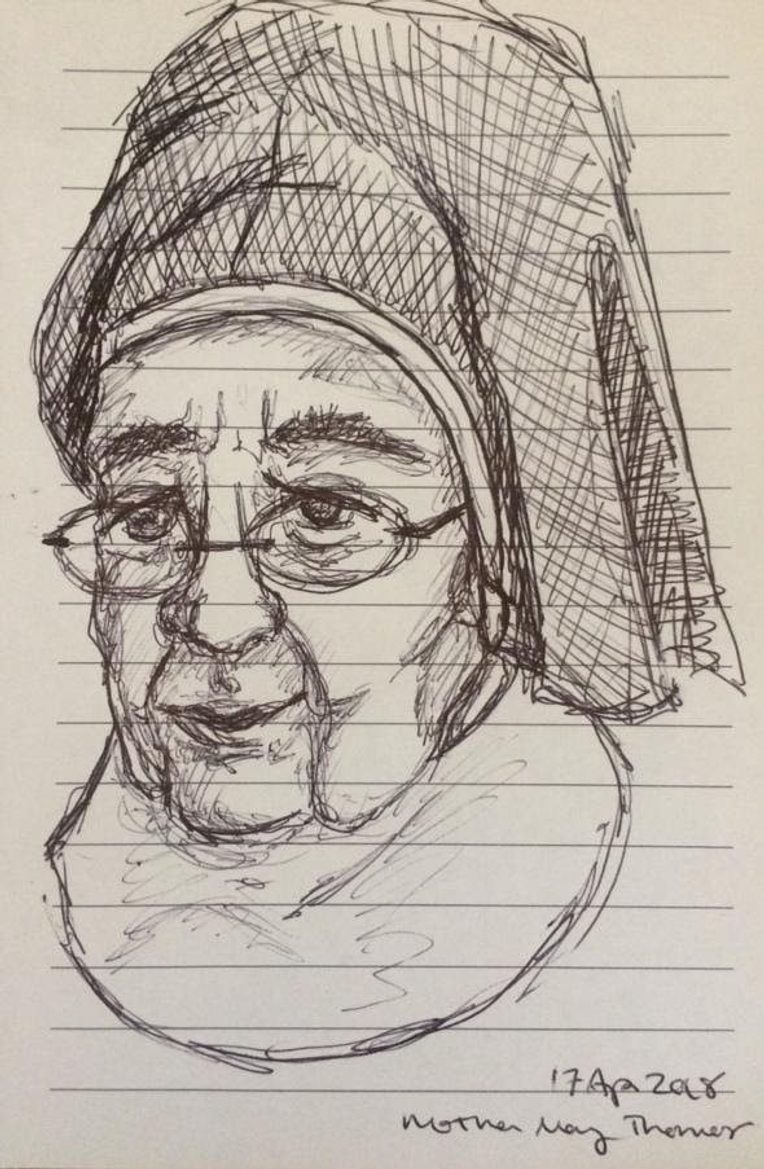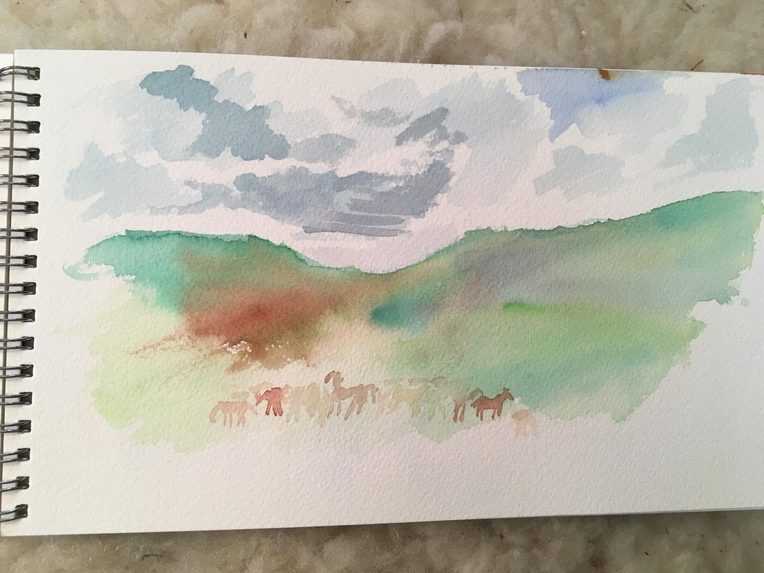
Fieldnote-taking and writing in the field comes rife with complexities of representation, what Michael Taussig (2011, 13) has described as “that drive to get it all down in writing just as it was, that relentless drive that makes you feel sick as the very words you write down seem to erase the reality you are writing about.” If this textual drive erases, as Taussig suggests, or in another sense forecloses, certain vibrancies and realities in the field, what might allow access to the pre-erasure, pre-foreclosure? How, instead, do we pursue other openings?
“Openings” signal an otherwise: an alternate point of entry, a passage between interior and exterior, or perhaps the gaps and spaces where light gets through, illuminating that which was previously hidden. Here, the concept of openings offers a lens to consider the affordances of alternate field practices, alternate ways of being in the field and creating from embodied experience, beyond our more traditional tools. Ways of “being there” that strip down the paralysis of “authorial presence” (Geertz 1988) to reveal something else. Openings.
Field sketching is one such practice anthropologists in the field have employed to reckon with the paralytics of representation, one championed by Taussig (2011) himself in his ode to the practice, I Swear I Saw This. As someone who relies more heavily upon photography, video, and audio as alternate ethnographic methods, I found myself curious what exactly the practice of sketching offered. I reached out to three of my colleagues from Princeton who were each in the field—Tyler Adkins in the Altai region of southwestern Siberia, Hannah Bradley in the Eg-Uur river valleys of Hovsgol Province, Mongolia, and Grace Carey in the privately owned town of Ave Maria, Florida. I knew that each of these individuals had some sort of drawing practice linked to their fieldwork. I wanted to understand what openings my colleagues were discovering through sketching (and also painting, in the cases of Hannah and Grace) as they sought to relate with their fieldsites, interlocutors, and even themselves, beyond the textual paradigm.
Through interviews with Tyler, Hannah, and Grace, as well as in the process of curating their sketches, I began to recognize that the act of field-sketching, not merely the sketches themselves as artifacts, seems to offer fieldworkers detours and swerves from capturing what they observed or experienced in text. In departing from the textual paradigm, the embodied practice of sketching offers alternative inroads to ethnographic proximity in ways the silo of writing simply cannot. In its partiality, incompleteness, and roughness, sketching allowed access to the dynamic in-formation as opposed to static information. My colleagues’ myriad engagements and experiments in field sketching illuminated myriad openings. Openings that resist the impetus to over-theorize. Openings that distract a bored and tired fieldworker’s mind. Openings that cultivate intimacies. Openings that suggest new ways of seeing. Openings into alternative temporalities. Openings into the surreal, occult, invisible.
In the following curation, I blend my colleagues’ field sketches with musings that arose in our conversations about sketching as process, in an effort to procure a dialogical conversation between image and practice, all with an eye for the openings not otherwise offered by text-based representation. Yet as the curated images suggest themselves, field sketching becomes so much more than just an escape from the paradigm of the textual; it suggests a movement toward deeply nuanced, expanding ways of engaging with and experiencing one’s field.
Opening 1: Inoculation against Theorizing (Non-instrumental)
Tyler, who has been conducting fieldwork on food, sociality, and the senses as modes of experiencing history among the Altai people of southwestern Siberia, found field sketching an antidote to the impulse to turn every observation into a finding or theory, what he referred to as instrumentalizing:
“I started sketching in my field notebook last year just because it was the only way I could think of to sit and think with what I was seeing in a totally noninstrumental way. With the fieldnotes themselves, even at their most sketchy and unpolished, I have the nagging sense that they’re a distant dress rehearsal for the dissertation. I find it hard to inoculate myself against theorizing there.”


While upon first glance, Tyler’s images, with arrows and text, may appear as diagrams, their function for him is . . . decidedly less functional. In fact, Tyler emphasized a particular “uselessness” of the images themselves (“The drawings aren’t even that legible or clear to me! They’re pretty useless.”) “Uselessness,” here, was not an adjudication of their worth, but rather a counterpoint to the mandate to produce something “useful” or instrumental. For Tyler, “uselessness” has a freeing quality, an anchoring which allows him to find greater presence in the field. “There’s no place for my sketches to go other than the notebook,” he explains, “which is nice when I’m trying to keep my brain in the notebook, in Siberia, and not trying to make some theoretical point back in Princeton.” He found this “uselessness” ironically useful and meaningful in other ways, “if only for my benefit as a human being and not as an anthropologist.”
Opening 2: Palliating Boredom
The most practical (and perhaps honest) impetus for drawing and sketching in the field began with the periodical mundaneness, even boredom, of fieldwork. In these “fieldwork droughts,” as Grace called them, field sketching stepped in, quite simply, as something to do.

“I was . . . really bored,” Grace recalled with a laugh as she recounted a multi-hour group Skype with one of her interlocutors, Mother Mary Thomas. “My interlocutors (a book club circle) were Skyping her on a large screen, and I just remember her huge face. She smiled with her eyes, and I wanted to capture that.”

“Sketching was a tool for staying present in the conversation,” Grace explained, remembering that the act implored her to repeatedly look up at the screen, to study Mother Mary Thomas’s face. “After the Skype, an interlocutor scanned the image and sent it to Mother Mary Thomas herself.”
Hannah described her drawing practice, in moments of boredom, as born out of “wanting to do something myself,” reclaiming a portion of the day after fieldwork to reflect and create. In a manner she describes as “very pre-meditated,” she chose to bring travel watercolors to Mongolia to rekindle her painting practice. After hours in the evenings, she would sit in camp with her watercolors and paint her surroundings. Hannah grew to think of landscape painting itself as a methodology, capable of capturing powerful intricacies of landscape (a theoretical interest of her larger work) in ways that exceeded written descriptions.


Opening 3: Alternative Routes to Proximity and Intimacy
Sometimes, the act of sketching actually generated fieldwork encounters. “Sketching invited people to approach me to ask what I was drawing, which often opened new floodgates,” Grace recounts. By returning multiple times to sketch the same site (the Ave Maria town square) she attracted the attention of future interlocutors, who grew curious about what she was drawing, and why.
Sometimes, these encounters grew into an intimacy in which Grace would draw portraits of her interlocutors. “Somehow, I’m very comfortable with sketching people, sitting down with them. It’s very intimate. And the amount of time you take to sketch someone (versus simply taking a picture), it’s more relational. When you’re drawing a person, you’re also drawing the personality. You look for that person’s life in their face. It forced me to examine my intimacy with someone, or to examine them. To feel unguarded.”
Hannah, who was not conducting her formal dissertation research in Mongolia but rather participating in an interdisciplinary research project with other social, biological, and environmental scientists, found drawing a way to reclaim ethnographic agency.
“I enjoyed drawing because the interviews were just so formal,” she relayed. “We were very much being taken care of (by the Mongolian researcher). We had an interpreter, and there was just . . . so much distance, in the ethnographic sense. There was no feeling of picking up on stuff; I felt really dependent.” In such instances, as Hannah explained, “one tends to fall back on phenomenology. All you have is your own body and the very stilted interpretations you’re trying to communicate.” Painting and sketching, for Hannah, brought her own body, senses, and perceptions into relation with the fieldsite. “Drawing responds to that need (for closeness and proximity).”






Opening 4: Extended Looking and New Temporalities
Each of my colleagues described a temporal component to the act of sketching—demanding and inviting a different relationship to time in the field. Tyler called it “looking in an extended way.” Extended looking, for Hannah, manifested in an appreciation for the sensory qualities (and depth) of colors. “When you sit down to really look at something with an eye to do that color with your own brush, do what it’s doing with your colors, it’s much more complicated,” Hannah described. Her engagements with color and time are evident in her watercolors of water itself, (“not just blue”), and a fleeting herd of horses thundering by (“the texture of all of their backs, channeled by the fences, almost blueish grays in their light”).




Grace echoed Tyler and Hannah’s notion of sustained looking as having a temporally transformative quality. “When you look intensely at something over a period of time, the scene changes before your very eyes,” Grace explained. She described adopting Henri Lefebvre’s (2004) method of rhythmanalysis to hone her senses of the urban rhythms and transformations of the town center in Ave Maria. She would return to the same place repeatedly to make sketches in one sitting, which in practice ranged anywhere from five minutes to several hours.


Opening 5: The Worldly Otherworldly
Perhaps the most valuable role of sketching in the field, my colleagues articulated, was the inroads it offered into contending with the invisible, inexplicable, otherworldly, supernatural, and transcendent. As Tyler explained, the act of using the eyes as opposed to speech as a form of knowledge-making was salient with his interlocutors: “People here in Altai are also very suspicious of the capacity of speech to communicate knowledge. If you ask someone how to do a farm task or make a recipe they’ll usually tell you, ‘you have eyes, look!’”
This notion of “looking” took on a slightly different meaning for Grace, whose interlocutors often gestured to the presence of invisible spirits and archangels hovering over Catholic churches. As Grace explained, “Sketching allowed me to make visible the invisible that my fieldsite was richly populated by—angels, demons, saints, the otherworldly present in this world. My interlocutors were acutely aware of these invisible neighbors, some, who were gifted with 'the sight' could even see them, but it was only through their words channeled into my pen and paper that I too was able to see.”
Hannah recalled a particular conversation with a monk, who, when asked about his belief in river spirits, responded ambivalently, but also relayed his belief in parallel worlds. “He told me that what happens in one world, maybe we don’t understand it in this world, but maybe they connect somehow . . . or they can influence each other, we may not be able to see into that parallel world, but that doesn’t mean it doesn’t affect us,” Hannah recounted. For Hannah, the ever-changing river waters seemed to reflect this notion of the parallel worlds; she grappled with this transience both through writing poetry and through sketching.



Acknowledgments
A sincere thank you to Grace Carey, Hannah Bradley, and Tyler Adkins for their collaboration and for sharing their work—this piece is as much theirs as my own.
References
Geertz, Clifford. 1988. Works and Lives: The Anthropologist as Author. Stanford, Calif.: Stanford University Press.
Lefebvre, Henri. 2004. Rhythmanalysis: Space, Time, and Everyday Life. Translated by Stuart Elden and Gerald Moore. London: Continuum.
Taussig, Michael. 2011. I Swear I Saw This: Drawings in Fieldwork Notebooks, Namely My Own. Chicago: University of Chicago Press.